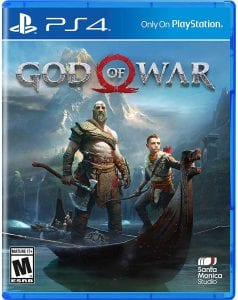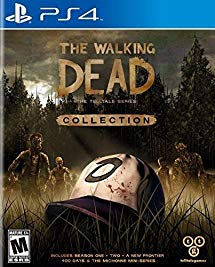Best Video Games

Our Review Process
Don't Waste Your Money is focused on helping you make the best purchasing decision. Our team of experts spends hundreds of hours analyzing, testing, and researching products so you don't have to. Learn more.
Our Picks For The Top Video Games
- 1. Nintendo The Legend of Zelda: Breath of the Wild
- 2. Activision Call of Duty: Black Ops 4
- 3. Konami Metal Gear Solid V: The Phantom Pain
- 4. Ubisoft Assassin’s Creed Origins
- 5. Sony God of War 4
- 6. Warner Brothers Middle-Earth: Shadow Of War Gold Edition
- 7. XBOX ONE Grand Theft Auto V
- 8. PS4 Assassin’s Creed Odyssey
- 9. Blizzard Overwatch: Origins Edition
- 10. Rockstar Red Dead Redemption 2
- 11. Square Enix Final Fantasy XIV
- 12. Ubisoft Watch Dogs 2
- 13. PS4 The Walking Dead Collection
- 14. PS4 TrackMania Turbo
- 15. PS4 Adam’s Venture Origin’s
It’s no surprise Nintendo’s “The Legend of Zelda: Breath of the Wild” is the best overall choice for best adventure games. Nintendo just keeps improving their world of Zelda, and in this particular game, you will find improved landscapes, challenging puzzles, outstanding background music and excellent mechanics that will keep you playing fo...
It’s no surprise Nintendo’s “The Legend of Zelda: Breath of the Wild” is the best overall choice for best adventure games. Nintendo just keeps improving their world of Zelda, and in this particular game, you will find improved landscapes, challenging puzzles, outstanding background music and excellent mechanics that will keep... Read More
If you're a "Call of Duty" fan, you'll love the multiplayer options built into Activision's "Call of Duty: Black Ops 4." There are several multiplayer modes, including those designed to pit two 5v5 teams against each other on missions. You may find the lack of a single-player campaign disappointing, though, if you plan to play solo sometimes.
Multiplayer OptionsPlay with as many as 10 total people with this game's multiplayer option.
Konami "Metal Gear Solid V: The Phantom Pain" is an open-world game, letting you choose your own path. The graphics provide mesmerizingly realistic visuals, and the ability to choose between solo and online team gameplay modes makes it appealing to many gamers. However, you may find the missions repetitive after playing for a while.
Konami "Metal Gear Solid V: The Phantom Pain" is an open-world game, letting you choose your own path. The graphics provide mesmerizingly realistic visuals, and the ability to choose between solo and online team gameplay modes makes it appealing to many gamers. However, you may find the missions repetitive after... Read More
Newly revitalized, Ubisoft "Assassin's Creed Origins" offers striking worldbuilding detail, even when you're in the middle of the desert. The changes move it in the direction of an RPG, but at heart it's still a stealth action game. For those who have 4K capabilities, this is the game that will best offer that level of resolution.
Newly revitalized, Ubisoft "Assassin's Creed Origins" offers striking worldbuilding detail, even when you're in the middle of the desert. The changes move it in the direction of an RPG, but at heart it's still a stealth action game. For those who have 4K capabilities, this is the game that will... Read More
Buying Guide
Whether you own a Nintendo, PlayStation or Xbox, picking a video game is always a challenge. There always seems to be an endless stream of games old and new, each just as appealing as the last. You may be constantly watching lists of new releases, trying to figure out which one will provide the best experience.
The first thing to consider is the type of gaming system you have. For those with a Nintendo Switch, the experience will be different than for gamers on an Xbox or PlayStation 4. When you’re in docked mode, that difference won’t be that noticeable. However, as soon as you start playing in handheld mode, you’ll notice how the gaming experience needs to be optimized for that format.
Another consideration is how important sharp, crisp visuals are to you. Most game developers will prioritize this, realizing that today’s gamers expect the best. Whether you’re swinging around New York City on a spiderweb or fending off zombies, a vivid, immersive environment is always a great touch.
That becomes a bit more challenging when you’re playing a classic game. It can be tough to balance the need for an updated look with the craving many gamers have for a classic gaming experience. This is particularly important if you’re playing a game that’s been around for a while, like “Super Smash Brothers.” The best games update the experience while still staying true to the original.
But no matter how a game looks, the thing that really makes a game a favorite is how long it stays interesting. Today’s newest games pack in plenty of new experiences and choices, ensuring that every time you sit down at your console, you head out on a new adventure. With each new release even of the most classic games, developers make sure that gameplay stays exciting long after that first session.
What to Look For
- Nintendo Switch’s “Super Smash Bros. Ultimate” brings the characters and gameplay you already know to the Nintendo Switch. New characters are mixed in with classics to make this game a blend of the familiar with today’s style of gameplay. New features include the World of Light campaign.
- PS4’s “Kingdom Hearts 3” combines Disney and Final Fantasy for a thrilling game experience. The new release introduces mostly new storylines and improved battles and worlds.
- Everyone knows Spider-Man from the comic books and movies. But PS4’s “Marvel’s Spider-Man (Insomniac)” remains true to the superhero you already know and love. Insomniac has built in plenty of character development for Peter Parker, balancing the dark and light tones of the storyline for a great game experience.
- If a zombie story is more your style, Xbox’s “ONE World War Z” is the game to choose. This version of the game packs in plenty of gore, so it’s not for everyone, but if gruesome is your preference, you won’t be disappointed.
- Playing games on mobile gaming systems can require a little bit of an adjustment, especially if you’re used to playing on a much larger screen. Nintendo Switch’s “Super Smash Bros. Ultimate” has been specially formatted for the Switch, but you may find that the many ideas, wishes and demands you’re given can be a bit overwhelming.
- Responsiveness is always important in a game. You’ll find the controls on the Nintendo Switch’s “Super Smash Bros. Ultimate” are responsive, even if you’re at the beginner level. PS4’s “Kingdom Hearts 3” and Xbox’s “ONE World War Z” have responsive controls, as well.
- Things can get a bit more complicated with PS4’s “Kingdom Hearts 3” when you’re on the Gummi Ship. The menus and building interfaces can be complicated and frustrating, so it may take some time and practice to get used to it.
- Today’s gamers demand breathtaking visuals with their games. Nintendo Switch’s “Super Smash Bros. Ultimate” jumps off the screen, whether you’re playing in handheld or docked mode. The entire look of the game has been updated to honor the classic look of the game while refreshing it for today’s gamers.
- PS4’s “Kingdom Hearts 3” also benefits from a complete update, with the end result being a crisper look with impressive attention to detail.
- You’re likely already familiar with Spider-Man’s swings across New York City, and that’s exactly what you’ll get with PS4’s “Marvel’s Spider-Man (Insomniac).” You’ll enjoy realistic trips around Manhattan with plenty of jaw-dropping animations.
- As intense as the action is with Xbox’s “ONE World War Z,” developers didn’t forget to pack in impressive visuals, including ensuring the game moves at a solid framerate.
- One of the worst things that can happen with any new game is that it quickly gets boring. Nintendo Switch’s “Super Smash Bros. Ultimate” keeps you engaged by packing it with more than 70 characters. This is the biggest roster so far for a “Super Smash Bros.” game, promising to keep you entertained for a while. You also get a map with plenty of secret locations and homages to the classic game that will ensure you never get bored.
- PS4’s “Kingdom Hearts 3” draws you in and keeps you engaged with battles. You’ll get fast-paced combat and plenty of different ways to fight to let you keep mixing things up long after you play the first game.
- Among the many things keeping PS4’s “Marvel’s Spider-Man (Insomniac)” interesting for hours is the costume options. Each costume comes with its own powers, helping you try out different scenarios with each session.
- If you like a little music with your gameplay, you’ll love the music options in PS4’s “Marvel’s Spider-Man (Insomniac),” which enhance your experience as you swing around the city. The music in Xbox’s “ONE World War Z” is also impressive. Disney fans will be especially interested in the classic Disney music featured in PS4’s “Kingdom Hearts 3.” Lastly, Nintendo Switch’s “Super Smash Bros. Ultimate” provides a soundtrack you can actually take with you. Look for a button in the Vault tab labeled Sounds, where you’ll find more than 800 musical tracks that you can load onto your smartphone to take with you.
More to Explore
“Super Smash Bros.” and “Kingdom Hearts” are both known as crossover games, a genre that blends characters and storylines from multiple games into one. Crossovers aren’t unique to video games. In fact, you’ll see them in books, movies and comic books. In video games, crossovers are believed to date back to 1988, when Battle Soccer combined characters from “Godzilla,” “Ultraman,” “Gundam” and “Kamen Rider.”
Today, crossovers are often seen when a company like Nintendo wants to combine characters from various games for promotional purposes, as is the case with the “Super Mario Bros.” crossovers like “Super Smash Bros.” But there are plenty of instances where characters across various properties come together in one game to attract the broadest range of fans.

























